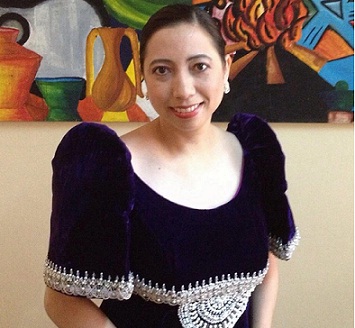THIS year is the 4th death anniversary of baritone Gamaliel Viray and Santa Isabel College Conservatory of Music will pay special tribute to him with a performance of Mendelssohn’s monumental oratorio, “Elijah” on February 22 at the school’s Santo Cristo de Tesoro Auditorium to be conducted by Dr. Raul Navarro.
The presentation will also launch the Gamaliel Viray Music Festival, a bi-annual event to commemorate the life and art of the late beloved bass-baritone. The concert will also celebrate the 150th presence of the Daughters of Charity in Santa Isabel College.
The soloists include Santa Isabel music faculty, alumni, guest performers and students, led by Viray’s protégé, baritone Joseleo Logdat, Grand Prix Winner of the 6th Yokohama International Music Competition and currently finishing his studies in Elisabeth University of Music in Japan.
Points out Logdat:“Mr. Viray has always been my inspiration. I am glad that I was the first and the last vocal performance student who graduated under him. As a person, he was always supportive of me. He will always have a place in my heart.”
Viray passed away on October 19, 2010.
 During his time, Viray not only appeared in operas. He acted in straight plays; he was a character actor in many FPJ blockbusters; he hosted radio programs promoting classical music and nurtured young and promising singers as a teacher. He belonged to the most distinguished batch of singers that the country has ever produced, which included Evelyn Mandac (the first and last Filipino to sing at the Metropolitan Opera of New York) and Otoniel Gonzaga (the first and last Filipino to sing Verdi’s “Otello”. As it was, Gamy was one of the central figures during the rise and fall of opera in the country.
During his time, Viray not only appeared in operas. He acted in straight plays; he was a character actor in many FPJ blockbusters; he hosted radio programs promoting classical music and nurtured young and promising singers as a teacher. He belonged to the most distinguished batch of singers that the country has ever produced, which included Evelyn Mandac (the first and last Filipino to sing at the Metropolitan Opera of New York) and Otoniel Gonzaga (the first and last Filipino to sing Verdi’s “Otello”. As it was, Gamy was one of the central figures during the rise and fall of opera in the country.
In 1979, when the Manila Metropolitan Theater had more opera productions than the Cultural Center of the Philippines (CCP), he was Zurga in Bizet’s “Pearl Fishers,” with the Leila of soprano Eleanor Calbes. In 1990, he was Germont in the controversial production of “La Traviata” at the CCP and Marcello in “La Boheme,” with National Artist for Theater Rolando Tinio directing.
What caused the controversy in the 1991 Traviata production? Tinio, who wanted to introduce the opera to a new generation of opera lovers, translated the opera in Pilipino and localized it by changing the setting of the opera from Paris to Binondo.
One wrote of the baritone in a 1990 issue of the Daily Globe thus: “Next to the Violetta of Donna Maria Zapola, the Germont of Gamaliel Viray registered with such authority that echoed in his singing. He once again showed that confident singing he earlier revealed as Zurga in the 1981 production of “Pearl Fishers.” Tinio’s translation of “Di provenza il mar” sang with such fervor by Viray is another good argument in favor of opera translation.”
 A finalist in the Concours International du Chant in France and the Francisco Vinas Vocal Competition in Spain, Viray was also Marcello in the CCP production of “La Boheme,” with the Rodolfo of tenor Harry Theyard, who is identified with the Metropolitan Opera of New York. He was also Papagueno in the 1981 CCP production of “Magic Flute” under Sarah Caldwell, and Count Almaviva in “Marriage of Figaro,” which was mounted by the then newly-born but short-lived Opera Company of the Philippines. He made his American operatic debut with the Opera Company of Boston as Burundai in Rimsky-Korsakov’s “The Invisible City of Kitezh.”
A finalist in the Concours International du Chant in France and the Francisco Vinas Vocal Competition in Spain, Viray was also Marcello in the CCP production of “La Boheme,” with the Rodolfo of tenor Harry Theyard, who is identified with the Metropolitan Opera of New York. He was also Papagueno in the 1981 CCP production of “Magic Flute” under Sarah Caldwell, and Count Almaviva in “Marriage of Figaro,” which was mounted by the then newly-born but short-lived Opera Company of the Philippines. He made his American operatic debut with the Opera Company of Boston as Burundai in Rimsky-Korsakov’s “The Invisible City of Kitezh.”
It may be recalled that in Boston Opera where he debuted in a Rimsky-Korsakov opera directed by Sarah Caldwell, there were two contrasting shows in the Boston opera house. Inside, he was singing a Rimsky-Korsakov aria while outside, anti-dictatorship demonstrators were chanting about poverty in the Philippines.
Soprano Rachelle Gerodias — who worked with Viray in three opera productions, namely the Rolando Tinio version of Puccini’s “La Boheme,” “Gianni Schicchi” and in the world premier of Fr. Manuel Maramba’s “Lord Takayama Ukon” – remembers the late baritone thus: “Boheme was very important to me because it was the Rolando Tinio adaptation of ‘La Boheme’ at the CCP, which was my very first opera production. We had two sets of cast: a junior and senior one. I was Musetta in the junior cast and Tito Gamy was the Marcello in the senior cast. In ‘Gianni Schicchi,’ I actually performed with him as his daughter, Lauretta, while he played the title role of Gianni Schicchi, to whom I sang the famous aria ‘O mio babbino caro.’ I remember his portrayal of that role very well. I thought he was the perfect Schicchi, and singing Lauretta with him was such a great honor and pleasure for me.”

